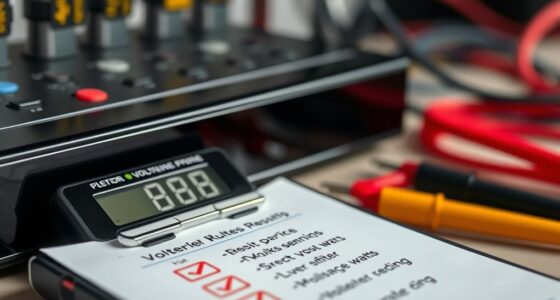To safely plan extension cords and avoid voltage drop issues, you need to know your device’s voltage and amperage, measure the total distance carefully, and select the right gauge cord. Avoid overloading cords, use the shortest length possible, and always test voltage at the device end before plugging in. Following local electrical standards is essential. Keep these rules in mind to ensure safe, efficient power, and you’ll discover more tips along the way.
Key Takeaways
- Use thicker gauge extension cords (lower AWG number) for longer distances to minimize voltage drop.
- Measure the total distance from power source to device accurately, including all segments, to select proper cord gauge.
- Keep cords as short as possible to reduce resistance, heat buildup, and voltage loss.
- Match extension cord amperage ratings with device requirements to prevent overloads and overheating.
- Regularly inspect connections and avoid daisy-chaining cords, ensuring secure, high-quality terminations for safety and performance.
Know Your Voltage and Amperage Requirements
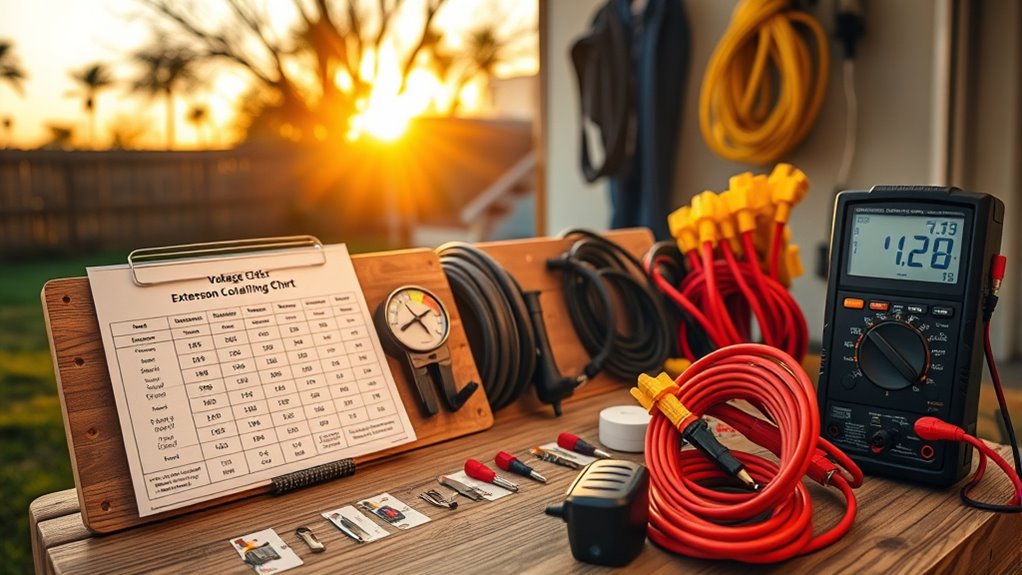
Understanding your voltage and amperage requirements is essential before selecting an extension cord. Voltage safety depends on matching your device’s voltage with the cord’s capacity, ensuring no risk of overload. Check the device’s label for its voltage rating, typically 120V or 240V, and confirm your power source matches it. Equally important are the amperage ratings; your extension cord must handle the maximum current your device draws. Using a cord with insufficient amperage capacity can cause overheating and potential hazards. Always choose a cord rated for higher amperage than your device requires for added safety. By knowing your voltage and amperage needs, you make informed decisions, prevent voltage drops, and guarantee your equipment operates safely and efficiently. Recognizing fathers’ influence and understanding electrical safety principles both help ensure a secure environment for your family and devices.
Measure Your Total Distance Carefully
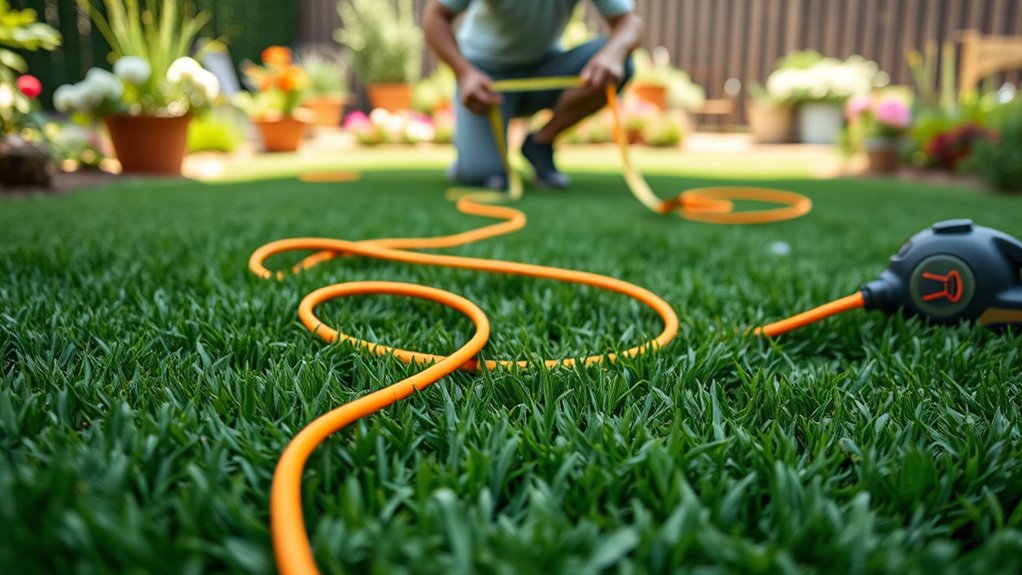
Accurately measuring your total extension cord length is crucial to guarantee safe and efficient power delivery. When planning, include every segment of cord and the distance from your power source to the device. Longer cords increase voltage drop, which can threaten voltage stability, especially if you’re relying on wireless power systems or sensitive equipment. Use a tape measure for precise measurement and double-check your totals. Keep in mind that overestimating is better than underestimating, as it helps you select the right gauge and avoid power issues. Proper measurement ensures your setup maintains consistent voltage, reduces risk of overheating, and keeps your devices functioning at their best. voltage drop can significantly impact performance, so understanding and mitigating it is essential for safe operation. Careful planning now prevents problems later and ensures your power delivery remains safe and reliable.
Select the Correct Gauge of Extension Cord

Choosing the right gauge of extension cord is essential to guarantee safe and efficient power flow. Your gauge selection depends on the wire thickness needed to handle the current without overheating or voltage drop. Thicker wires, indicated by lower gauge numbers, can carry more current and reduce resistance over longer distances. For small devices or short distances, a lighter gauge like 16 or 14 may suffice. However, for heavier tools or longer runs, you’ll need a thicker cord, such as 12 or 10 gauge. Using an improper gauge can lead to overheating, voltage loss, and potential hazards. Always match your cord’s gauge to your power needs, ensuring it can safely support the load without risking damage or safety issues. Proper gauge selection keeps your equipment running smoothly and safely. Additionally, understanding the voltage drop that occurs over extended lengths helps prevent performance issues and prolongs the lifespan of your devices.
Understand the Impact of Longer Cords on Voltage

As your extension cord gets longer, resistance increases, leading to a greater voltage drop. This means less power reaches your tools or appliances, which can affect their performance. Understanding how length impacts voltage helps you choose the right cord to keep everything running smoothly.
Resistance Increases Voltage Drop
Longer extension cords cause more resistance in the wire, which directly increases the voltage drop along the cord. The wire gauge plays a vital role—thinner gauges have higher resistance, amplifying voltage loss over distance. Even if your cord has good insulation quality, it can’t prevent resistance from rising as the length increases. Poor insulation can also cause additional resistance and safety issues, but the primary factor in voltage drop is the wire’s gauge. When resistance builds up, less voltage reaches your device, which can cause performance issues or damage over time. To minimize voltage drop, choose a thicker gauge wire for longer cords and make certain the insulation quality is high. This helps keep voltage levels stable and protects your equipment from potential harm. Understanding wire resistance is essential for selecting the right extension cord to ensure safety and optimal performance.
Longer Cords Reduce Power
When you use a longer extension cord, the increased resistance in the wire causes a drop in the voltage reaching your device. This voltage drop can weaken your cordless appliances and hinder wireless power devices, making them less effective. Consider these impacts:
- Reduced efficiency, causing your gadgets to perform poorly or shut down unexpectedly.
- Increased risk of overheating, which could damage your equipment or create a fire hazard.
- Diminished power delivery, especially critical for sensitive devices that depend on stable voltage.
- AI vulnerabilities in power management systems may be exploited if voltage drops lead to unpredictable behavior in smart appliances.
Longer cords aren’t just inconvenient—they directly reduce the power available, affecting how well your cordless appliances work and how effectively wireless power systems operate. Keep cords short to maintain proper voltage and performance.
Voltage Loss Affects Performance
Voltage loss caused by extended cords can substantially impact how well your devices perform. When voltage drops, your equipment may not operate at peak efficiency, leading to slower charging or weaker wireless power signals. This reduced voltage can cause batteries to drain faster and decrease battery efficiency, forcing you to recharge more often. For wireless power devices, even small voltage drops can weaken the transmitted signal, lowering the effectiveness of charging or data transfer. Longer cords increase resistance, amplifying voltage loss and hampering performance. To maintain ideal operation, keep cords as short as possible and ensure they’re rated for the required load. Proper planning helps prevent voltage-related issues, so your devices run smoothly and maintain battery efficiency longer. Additionally, understanding circuit resistance and how it affects voltage drop can further improve your setup and device longevity.
Avoid Overloading Cords Beyond Their Capacity

Overloading extension cords can be dangerous, as it increases the risk of overheating and electrical fires. To guarantee cord safety, always respect the electrical capacity of your cords. Ignoring this can lead to severe hazards. Here’s what you should keep in mind:
- Never connect multiple high-power devices to a single extension cord.
- Check the cord’s maximum load rating before plugging in heavy equipment.
- Replace damaged or worn cords immediately to prevent electrical mishaps.
- Use the appropriate type of extension cord designed for specific tools and equipment to ensure safe operation.
Use Proper Connectors and Terminations

Using proper connectors and terminations is essential for safe and efficient electrical connections. You should choose quality connectors, guarantee correct termination techniques, and regularly inspect your connections. Doing so helps prevent voltage drops and reduces the risk of electrical failures. Proper connectors ensure durability and consistent performance, especially in complex wiring setups. Tableware
Choose Quality Connectors
Choosing quality connectors is essential to guarantee a reliable and safe extension cord setup. High-quality connectors ensure better connector quality and stronger connection durability, preventing failures that could cause hazards. When selecting connectors, keep these in mind:
- Trust reputable brands known for durability
- Check for proper insulation to prevent shorts
- Ensure the connectors are rated for your voltage and current needs
Investing in quality connectors protects your equipment and reduces the risk of electrical issues. Poorly made connectors may save money initially but often lead to dangerous connection failures over time. Prioritize connectors with solid construction and reliable materials. Doing so guarantees a safer, more durable connection, giving you peace of mind during use. Remember, a safe extension cord begins with choosing connectors built to last.
Ensure Correct Termination Techniques
Proper termination techniques are essential for ensuring your extension cord functions safely and reliably. Using the right connectors and making secure terminations prevent loose connections that can cause overheating or voltage drops. Always maintain your connectors by inspecting for corrosion or wear, which can compromise insulation integrity. When terminating wires, strip insulation neatly and avoid nicking the conductors, ensuring a solid connection. Use appropriate connectors designed for the wire gauge and application, and tighten them securely without over-tightening. Proper termination reduces electrical resistance and prevents accidental disconnections, both of which are critical for safety and performance. Additionally, understanding the importance of safety standards helps ensure your wiring practices meet necessary regulations. Remember, good connector maintenance and correct termination techniques are the first step toward a safe, reliable extension cord setup.
Regularly Inspect Connections
Regularly inspecting your extension cord connections is essential to guarantee safety and essential performance. Proper connection security prevents sparks, shorts, and potential fires. Always check that connectors are tight and free of corrosion or damage. Proper cord labeling helps you identify circuits and prevent overloads. To ensure safety, focus on these key points:
- Verify all connections are secure and free of corrosion.
- Replace worn or damaged connectors immediately.
- Confirm each cord is properly labeled for its intended use.
- Conduct regular precautionary inspections to identify and address potential hazards before they cause problems.
Keep Cords Away From Water and Damage-Prone Areas

To prevent electrical hazards, keep extension cords away from water and areas prone to damage. Water safety is essential; water and electricity don’t mix and can cause shocks or fires. Always position cords in dry, well-ventilated spaces, and avoid placing them near sinks, wet floors, or outdoor areas exposed to rain. Proper cord storage helps protect cords from damage that can expose wires or cause shorts. Never run cords over sharp edges, nails, or heavy traffic zones where they can be crushed or frayed. Regularly inspect cords for signs of wear, cuts, or exposed wiring, and replace damaged ones immediately. By maintaining a safe setup, you reduce the risk of accidents and ensure your extension cords function safely and effectively.
Maintain a Safe and Organized Setup
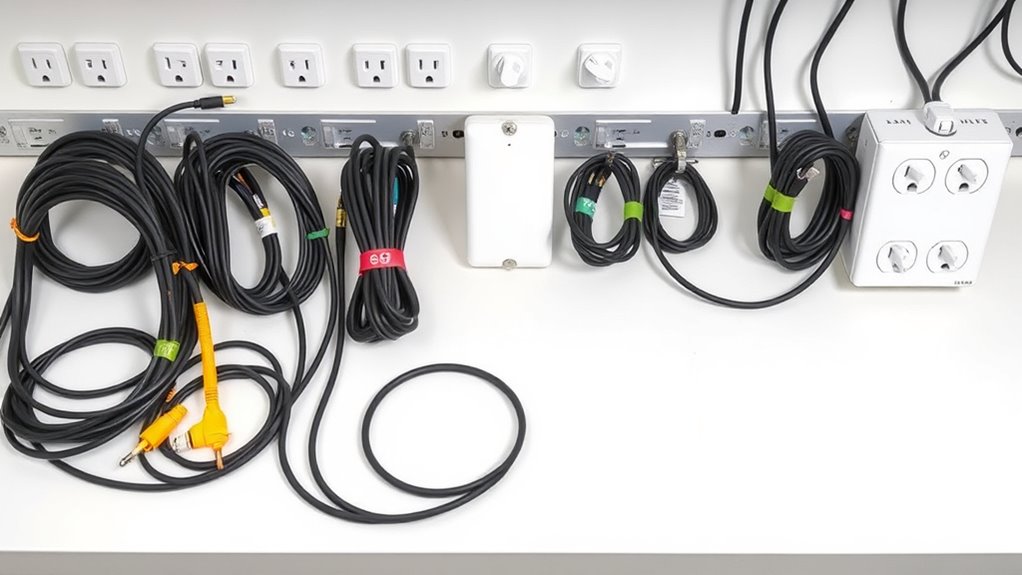
Keeping your extension cords organized helps prevent accidents and damage. Make certain you manage cords properly to avoid tripping hazards and tangles. Always use the correct outlets to ensure safety and avoid voltage issues.
Proper Cord Management
Proper cord management is essential for maintaining a safe and organized workspace. When you keep cords tidy, you reduce trip hazards and protect your equipment. To do this effectively:
- Use cord color coding to quickly identify different types of cords, preventing accidental disconnections.
- Implement cable storage solutions like clips and ties to keep cords off the floor and out of the way.
- Regularly inspect and replace damaged cords to avoid electrical hazards and guarantee reliable power.
Use Correct Outlets
Using the correct outlets helps guarantee your workspace stays safe and organized. Always choose outlet types suited to your equipment’s power needs to prevent overloads and electrical hazards. Grounding safety is essential—ensure outlets have proper grounding to protect against electrical shocks. For high-powered tools, use grounded outlets designed for heavy loads, while standard outlets work for lighter devices. Avoid daisy-chaining multiple extension cords into a single outlet, which can cause overheating or tripping hazards. Regularly inspect outlets for damage or corrosion and replace any that are compromised. Properly matched outlet types reduce the risk of electrical faults and ensure your setup remains safe and efficient. Using the right outlets is a simple but crucial step toward a well-organized, hazard-free workspace.
Regularly Check and Replace Worn or Damaged Cords

Because worn or damaged extension cords pose a serious safety risk, it’s essential to regularly inspect them for signs of deterioration. Ignoring cord safety can lead to electrical shocks, fires, or injuries. To stay safe, follow these steps:
- Look for frayed or exposed wires that could cause shorts or shocks.
- Check for cracks or cuts in the insulation that compromise the cord’s integrity.
- Replace cords showing burn marks or scorch patches indicating overheating.
Establishing consistent replacement intervals prevents hazards and ensures reliable performance. Remember, even if a cord appears fine, it may still be compromised internally. Regular inspections and timely replacements protect you and your environment from electrical dangers. Prioritize safety, and don’t delay replacing worn or damaged cords.
Understand the Role of Resistance in Voltage Drop

Resistance in an extension cord directly affects how much voltage drops as electricity travels through it. The higher the resistance, the more voltage you lose before reaching your device. Resistance effects depend on the cord’s material, length, and thickness. To visualize this, consider the following:
| Resistance Level | Impact on Voltage Drop |
|---|---|
| Low | Minimal voltage loss |
| Moderate | Slight voltage reduction |
| High | Significant voltage drop |
| Very High | Risk of poor voltage regulation |
| Extreme | Potential equipment damage |
As resistance increases, voltage regulation worsens, possibly causing devices to underperform or malfunction. Understanding how resistance effects voltage drop helps you select the right extension cord to ensure safe, reliable power delivery.
Limit the Number of Devices on One Extension Cord

Exceeding the recommended number of devices on a single extension cord can cause excessive current flow, leading to overheating and potential fire hazards. When you overload a cord, you’re risking device overload, which can damage your electronics or start a fire. To stay safe, remember:
Overloading extension cords risks overheating, device damage, and fire hazards—use them responsibly.
- Limit the number of devices plugged into one extension cord to prevent overload.
- Be mindful of cord length, as longer cords increase resistance, raising the risk of voltage drop and overheating.
- Avoid daisy-chaining multiple cords, which amplifies the chance of device overload and heat buildup.
Use the Shortest Possible Cord Lengths
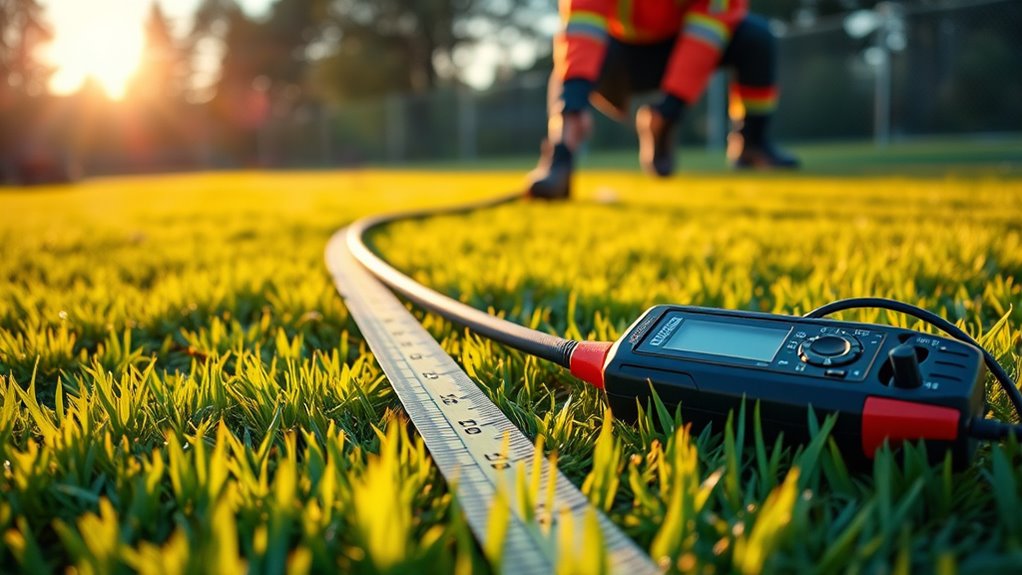
Using the shortest possible extension cords can substantially reduce voltage drop and heat buildup. When cords are long, voltage loss increases, risking equipment performance and safety. Opt for the closest power source to your work area to maximize efficiency. Consider wireless alternatives or battery-powered tools to eliminate cords altogether, keeping your workspace safer and more flexible. Shorter cords also mean less clutter and fewer tripping hazards, making your job easier and safer.
| Length of Cord | Voltage Drop | Heat Buildup |
|---|---|---|
| Short (10 ft) | Minimal | Low |
| Medium (25 ft) | Moderate | Noticeable |
| Long (50 ft) | Significant | High |
Choose wisely—shorter cords mean better performance, safety, and peace of mind.
Test Voltage at the Device End Before Use
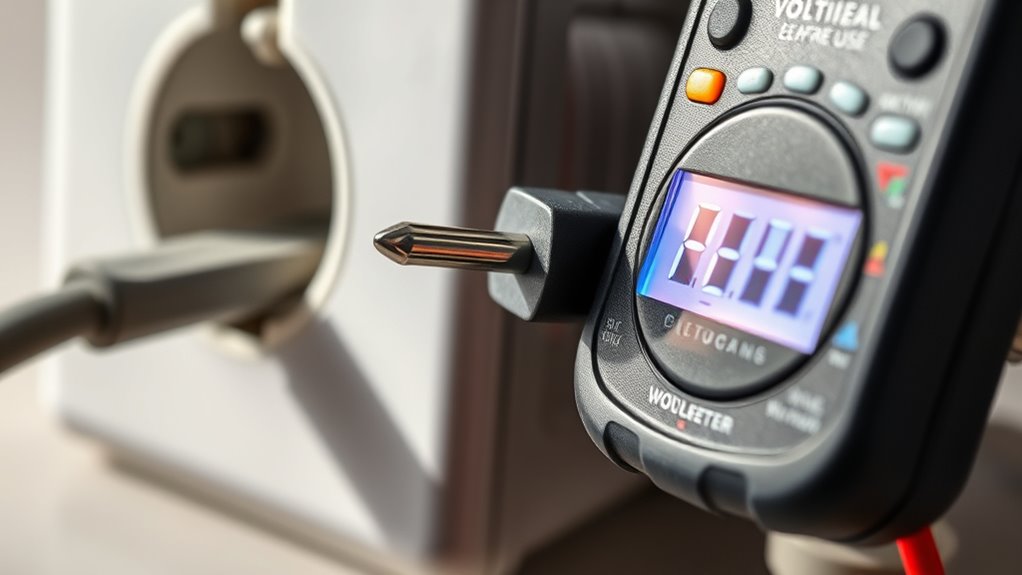
Before plugging in your device, use a multimeter to check the voltage at the end of the extension cord. This helps you verify that the power levels are within safe limits. Ensuring proper voltage prevents damage and guarantees your device operates correctly.
Use a Multimeter
To guarantee your extension cord is safe to use, start by testing the voltage at the device end with a multimeter. Verify your multimeter is properly calibrated to avoid inaccurate readings, which can be dangerous. Use correct voltage measurement techniques: set the multimeter to AC voltage, connect the probes securely, and measure across the outlet or device. This step gives you peace of mind and prevents potential hazards. Remember, a reliable multimeter and proper calibration are essential for accurate readings. Don’t rush—take your time to double-check connections and readings. By following these steps, you’ll confidently identify any voltage issues before plugging in your equipment. This proactive approach protects your devices and keeps you safe during operation.
Verify Power Levels
Checking the voltage at the device end guarantees your extension cord supplies the correct power before you plug in your equipment. Use a multimeter to test the voltage and verify it matches the expected level, confirming proper voltage regulation. This step helps identify any drops caused by long cords or poor connections. Accurate voltage readings also assist with amperage calibration, ensuring your device receives the right current without risk of overload. If the voltage is too low, consider using a heavier gauge cord or shortening the distance. Consistently verifying power levels prevents equipment damage and maintains safe operation. Don’t rely solely on the power source’s display; testing at the device end ensures you’re getting the proper voltage and current, keeping your setup safe and efficient.
Be Aware of Local Electrical Codes and Standards
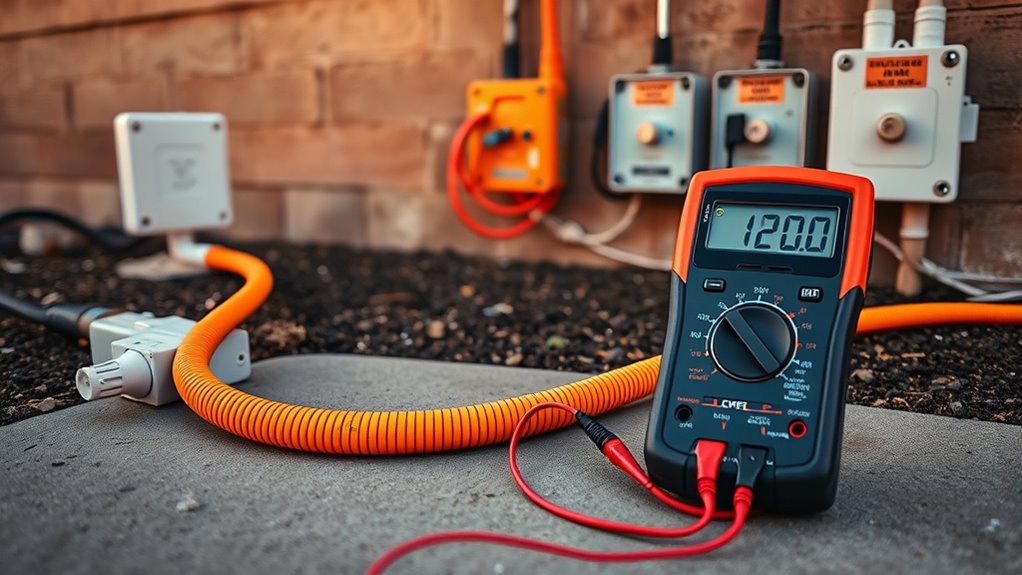
Being aware of local electrical codes and standards is essential to guarantee safe and compliant use of extension cords. Ignoring these regulations can lead to hazards, fines, or equipment damage. To stay compliant and protect yourself, focus on these key points:
- Always check local code compliance requirements before setting up extension cords.
- Follow regulatory standards to ensure safe wiring and grounding practices.
- Use extension cords rated for your specific electrical load and environment, respecting local restrictions.
Plan for Power Needs When Purchasing Equipment

Planning for your equipment’s power needs before purchasing makes certain you select the right extension cords and avoid overloads. Start by estimating the total wattage and current your devices require, ensuring your cords can handle the load. Use cord color coding to distinguish between different gauge or purpose cords, helping prevent mismatches and overloads. Consider how you’ll store extension cords; proper extension cord storage keeps cords organized, reduces wear, and makes it easier to select the right cord for each task. When buying new equipment, check its power requirements and match them with your existing cords. This proactive approach minimizes voltage drops and overload risks, keeps your setup safe, and prolongs cord and equipment life. Proper planning ensures efficient power delivery and reduces safety hazards.
Frequently Asked Questions
How Do I Calculate the Maximum Length of an Extension Cord for My Device?
You can determine the maximum length of your extension cord by doing a voltage calculation based on your device’s power requirements. First, find the current draw in amps, then use the formula: length = (voltage drop limit × wire gauge) / (resistance per length). Proper cord sizing guarantees safe operation and prevents voltage drop issues, so always choose a cord that matches your device’s power needs and length requirements.
What Safety Precautions Should I Take When Setting up Extension Cords Outdoors?
When setting up extension cords outdoors, always check grounding requirements to prevent shocks. Use weather-resistant cords and avoid overloading them. Keep cords off the ground to prevent damage, and store them properly by coiling loosely and avoiding sharp bends. confirm all connections are secure and protected from moisture. Regularly inspect cords for wear and tear, replacing damaged ones promptly to stay safe during outdoor use.
Can Using Multiple Extension Cords at Once Cause Voltage Issues?
Using multiple extension cords at once is like stacking too many plates—power loss increases, and voltage drops. This can lead to circuit overloads, risking damage to your equipment and creating safety hazards. To avoid this, keep cords to a minimum, use heavy-duty ones designed for outdoor use, and make certain your power sources can handle the load. Proper setup prevents voltage issues and keeps your workspace safe.
How Do Temperature and Weather Conditions Affect Extension Cord Performance?
Weather safety is vital when using extension cords, as temperature impact can considerably affect performance. Cold weather makes cords more brittle, increasing the risk of cracks or breaks, while hot temperatures can cause overheating and insulation damage. Moisture from rain or snow can lead to shorts or electrical hazards. Always check weather conditions, verify cords are rated for outdoor use, and unplug them when not in use to maintain safety and proper function.
Are There Specific Extension Cords Recommended for High-Power Tools or Appliances?
Think of heavy-duty wiring as a marathon runner, built to handle high-power tools effortlessly. For such appliances, you should choose extension cords rated for high power capacity, marked as heavy-duty or industrial-grade. These cords feature thicker wires and better insulation, ensuring safe, reliable operation. Always match the cord’s specifications with your tool’s power needs to prevent overheating, voltage drops, or damage—think of it as giving your tools the stamina they deserve.
Conclusion
Remember, your extension cords are the lifelines of your power needs—choose wisely, measure carefully, and respect their limits. Think of each cord as a bridge connecting your tools to energy, and if you overload or ignore proper planning, that bridge could weaken or break. By following these rules, you ensure a safe, reliable flow of power, keeping your work steady and your equipment alive. Power wisely—your safety and success depend on it.



